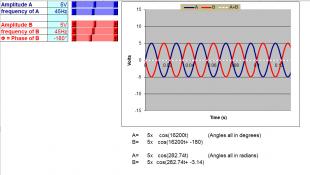Lots to play with here, just to make sure that you understand amplitude, frequency and phase. Especially important to note that phase is a RELATIVE parameter and the phase (here) of B is defined with respect to A. Check your understanding of this by setting both frequencies and amplitudes to be the same, with a phase difference on B of zero. A and B will overlap. Now increase the phase of B and you will see the peaks in B moving to the LEFT ... ie they occur sooner. This is a POSITIVE phase shift with respect to A. Now try a negative shift in phase. What happens? Are the peaks in B occurring later, as they should be?

Basics of Electronics ... a "Toybox" by Alan Murray, University of Edinburgh is licensed under a Creative Commons Attribution-NonCommercial-ShareAlike 4.0 International License.



